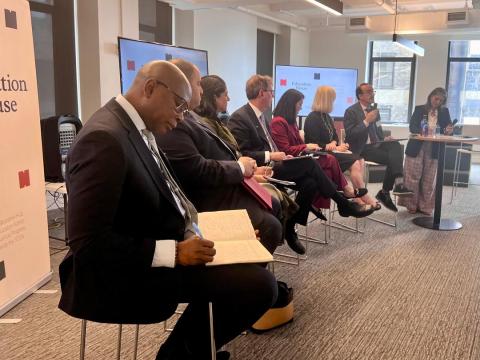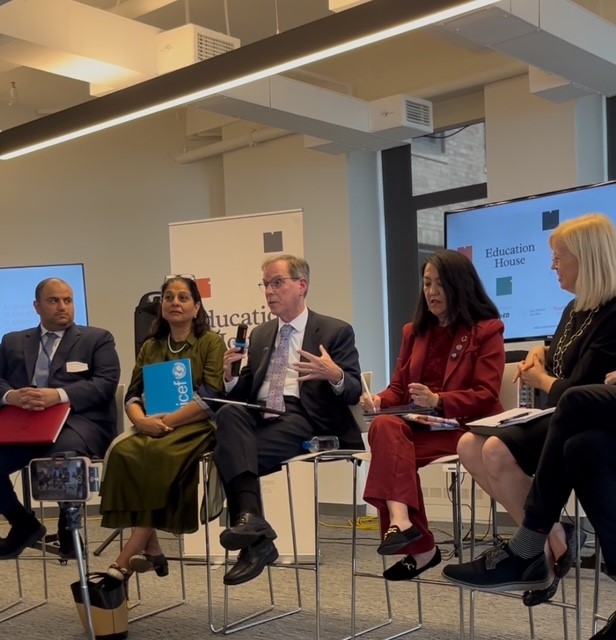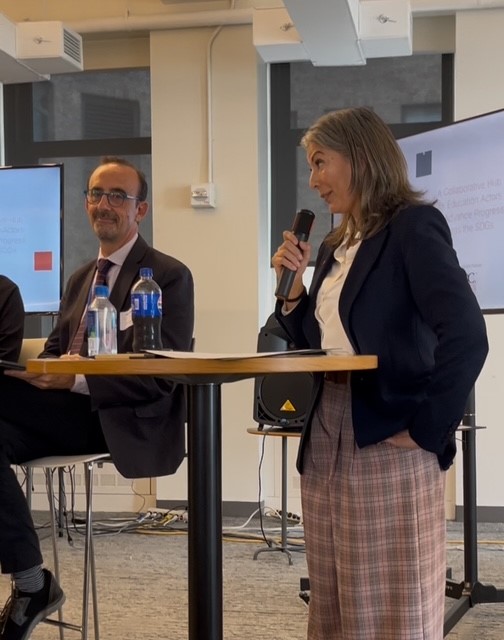From the Margins to the Center: Transforming Education Where It Matters Most

At this year’s UN General Assembly, World Vision convened a panel at Education House titled From the Margins to the Center: Transforming Education Where It Matters Most. Leaders from government, multilateral institutions, and civil society came together around a shared conviction: equity and inclusion in education are not optional add-ons, but the foundation of sustainable systems that deliver hope and opportunity for every child.
For World Vision, this is not only a moral imperative but a strategic priority. Guided by the principle of putting the forgotten first, we partner with communities, schools, civil society entities and governments to ensure that children in underserved communities, children with disabilities, girls, and those living in conflict or crisis are not left behind.
At the systems level, we focus on resilience, accountability, and local leadership, working to ensure equity and inclusion are not just aspirational but operational. As active members of local education groups, World Vision contributes to policy dialogue and financing discussions, while also helping fill critical gaps by working directly with schools and communities where education system actors often require additional support from development partners. From early childhood through adolescence, our programming addresses children’s needs holistically — combining foundational literacy and numeracy with social and emotional learning, protection, and wellbeing — so that education systems not only respond to access challenges, but also deliver meaningful learning and thriving futures.
The statistics are stark. More than 272 million children and youth are out of school globally, while nearly 600 million enrolled in school are not acquiring foundational skills. Rising costs, debt pressures, fragile contexts, and climate disruptions are straining already stretched systems. Without urgent action, millions more risk being left behind.
As Ana Tenorio, World Vision’s Global Director of Education framed it: “The challenge is not lack of evidence but lack of political will to scale and resource what works. We need joint action that makes equity non-negotiable—because education should be a story of hope, resilience, and transformation for every child.”
From Equity as a Value to Equity as a Strategy
One of the strongest threads running through the discussion was the distinction between equity as a value and equity as a strategic approach.
- As a value, equity reflects a moral commitment: the belief that every child, regardless of gender, disability, displacement, or background, deserves to learn and thrive.
- As a strategy, equity becomes more than a statement of belief. It becomes the lens that guides decisions, policies, budgets, and accountability. Rather than treating all schools or all learners equally, systems strategically allocate more support to those who need it most — rural girls, children with disabilities, children in refugee camps — to close persistent gaps.
In other words, equity as a value asks us to agree on fairness. Equity as a strategy ensures fairness is delivered through how systems are designed and how resources are deployed.
This shift from aspiration to action is critical. As Hon. Conrad Sackey, Minister of Education in Sierra Leone, explained through a vivid metaphor: “Equality is giving every child the same opportunity. Equity is giving each what they actually need.” His country’s Free Quality School Education programme has added over one million learners, but real inclusion demands tailored support — such as counsellors to help teachers identify and respond to children’s diverse needs, particularly those with disabilities.
Financing with Courage

Panelists agreed that equity can only become strategic if it is reflected in financing.
- Charles North of the Global Partnership for Education (GPE) highlighted that while many countries now dedicate 20% of budgets to education, the quality and equity of spending are what drive results. Through compacts and results-based financing, GPE helps align partners behind reforms that transform whole systems.
- Pia Rebello Britto of UNICEF argued that equity must be hardwired into policy and practice from the start, not added later. She applauded governments that are creating flexible, multi-pathway approaches — combining formal schooling, non-formal or accelerated learning, and digital or community-based routes — to reach children who would otherwise be left behind. She also stressed that financing must be tied to inclusion outcomes: “Equity must be hardwired into policy from the start… and incentives aligned so money talks.” In Ethiopia, for example, provincial budgets were supplemented only when gender enrollment targets were met, unlocking $4.2M and improving girls’ enrollment by 12%. Beyond financing, she emphasized delivery capacity as essential: retraining teachers, supporting frontline staff, and bundling services so children benefit from holistic support.
- Mohammed Saad Al Kubaisi of Education Above All pressed for urgency and innovation, particularly for the millions of children still out of school. “It’s not just about the cost of financing, but the cost of inaction,” he said, underscoring that every year of delay means more children excluded permanently. He called for bold approaches — using AI, financing multipliers, and new cross-sector partnerships — to bring out-of-school children back into education systems and ensure they are not left behind.
- Luis Benveniste of the World Bank underlined the importance of sustainable frameworks and robust data systems. “If we don’t see them, we don’t act — and if we don’t fund it systemically, we don’t reach scale.” He stressed that education management information systems (EMIS) are critical not just to track who is in or out of school, but also to enable accountability by linking financing and outcomes. Without disaggregated data on disability, refugee status, or learning progress, governments cannot direct resources effectively or be held accountable for results.
Centering Children’s Learning
Beyond systems and financing, panelists returned to the heart of the issue: children’s learning and experience.
Caitlin Baron of the Luminos Fund noted that in West Africa, one in three children are out of school and nine in ten in school are not learning. Yet accelerated “catch-up” programs show that children can make three to four years’ progress in one year: “When we value children’s time and their limitless capacity to learn, even one high-powered year can be transformative.”
Dr. Alexandra (Ale) Okada added that children thrive not only when they learn to read but when they grow in confidence, agency, and safety: “Children need joyful, relevant learning experiences if they are to thrive.”
A Call to Action
Together, panelists called us to radically raise our ambitions, guided not by what systems can currently deliver but by what children are capable of achieving. Equity is not about doing more, but about doing better: prioritizing the most marginalized, investing in what improves outcomes, and ensuring policies and interventions reach the right children, in the right way, at the right time.
For World Vision, this means continuing to move equity from aspiration to operational strategy. Through partnerships with communities, schools, and governments, we aim to embed equity and resilience at the heart of education systems. Our policies and strategies must match children’s potential, not our system’s limits. Education must be transformed from the margins inward, so that it becomes not a story of exclusion, but one of joy, hope, and generational transformation.
